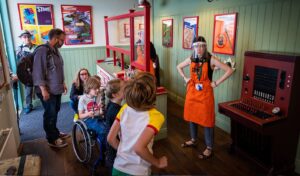Since its establishment, The Story Museum has become a central part of Oxford’s cultural landscape, attracting visitors and contributing significantly to the local economy. Below is an estimated breakdown of the quantified impact that The Story Museum has had on Oxford, with benefit titles, descriptions, beneficiaries, and estimated financial impacts.
The Story Museum has become a significant cultural and educational hub in Oxford, contributing to local economic activity, employment, and tourism.
Estimated Quantified Impact of The Story Museum on Oxford
| Benefit Title | Description | Beneficiary | £ Value Impact | Notes |
|---|---|---|---|---|
| Increased Foot Traffic to Oxford | The Story Museum attracts a steady stream of visitors annually, increasing foot traffic to nearby businesses such as cafes, restaurants, and shops. | Local Businesses (Retail, Dining) | £1.5–2.5 million annually | Based on an estimated 80,000–100,000 annual visitors, with an average additional spend of £20–£25 per visitor on surrounding services. |
| Direct Revenue from Ticket Sales | Revenue generated by The Story Museum through ticket sales for exhibitions, workshops, and special events. | The Story Museum (business) | £1.2–1.5 million annually | Based on ticket prices ranging from £8–£15, with an estimated annual visitor count of 80,000–100,000. |
| Job Creation (Direct Employment) | The Story Museum creates jobs in visitor services, education, event management, and operations. | Local Workforce | £700,000–£1 million annually | Estimated 20–30 full-time and part-time employees, with average salaries of £25,000–£30,000. |
| Indirect Job Creation | Increased foot traffic and visitor spending create additional jobs in local businesses, particularly in hospitality and retail. | Local Workforce | £300,000–£500,000 annually | Additional staff required in shops, cafes, restaurants, and local services to meet the demand generated by museum visitors. |
| Increased Retail and Dining Spending | Visitors to The Story Museum often combine their trip with shopping and dining in Oxford, boosting local business revenues. | Local Retailers, Restaurants | £1–2 million annually | Estimated based on retail and dining spend of £10–£20 per visitor. |
| Boost to Local Tourism | The Story Museum contributes to Oxford's tourism economy by attracting visitors, including families and school groups, from outside the city. | Local Hospitality Industry | £500,000–£1 million annually | Includes overnight stays, transport, and additional spending by tourists visiting The Story Museum and exploring other Oxford attractions. |
| Property Value Uplift | The presence of The Story Museum has contributed to an increase in local property values, particularly commercial properties. | Local Property Owners | £2–3 million total increase | Estimated uplift in property values due to increased foot traffic, area attractiveness, and local business activity. |
| Community Engagement and Social Impact | The Story Museum provides a space for community events, storytelling workshops, and educational programs, fostering local engagement. | Local Residents, Community Groups | Non-monetized | Although not directly monetizable, the social impact of community engagement and educational outreach is significant. |
Summary of Key Economic Impacts
Total Estimated Annual Economic Impact: £6.7–£9.9 million annually
- This includes direct revenue, job creation, increased local spending, and tourism revenue.
Job Creation:
- 20–30 direct jobs at the museum and additional indirect jobs created in local retail, dining, and hospitality businesses due to increased foot traffic and visitor numbers.
Retail and Hospitality Impact:
- Visitors to The Story Museum contribute to retail and hospitality spending, boosting nearby businesses, with a significant spillover effect on local hotels, restaurants, and shops.
Tourism Impact:
- The museum attracts tourists from outside Oxford, contributing to tourism revenue and increasing the attractiveness of the city as a destination for cultural visitors.
Property Value Uplift:
- Increased foot traffic and business activity in the surrounding area have likely led to a rise in property values, particularly for commercial properties near the museum.
Educational and Social Impact:
- The museum plays a vital role in educational programming, providing interactive learning experiences for schools and students, while also fostering community engagement through workshops and events.
Notes:
- Visitor Numbers: Estimates based on approximately 100,000 visitors annually.
- Spending Estimates: Calculations are based on industry averages for visitor spending in cultural destinations and local economic impact studies from similar museums.
- Property Value Impact: The impact on property values is estimated based on the regeneration effect that cultural institutions often bring to their surrounding areas.
- Educational Value: The museum’s collaboration with schools and its impact on literacy and creativity development are qualitative benefits that add educational value but are difficult to quantify directly.
Conclusion:
The estimated impact of The Story Museum showcases its role as a key driver of economic growth and cultural development in Oxford, bringing both direct and indirect financial benefits to the local community while contributing to the city’s cultural richness and social engagement.
Related Content

Case Study: The Story Museum – A Unique Celebration of Storytelling in Oxford
Overview The Story Museum in Oxford is a one-of-a-kind cultural institution dedicated to celebrating the art of storytelling in all its forms. Since its inception in 2003, the museum has evolved from a series of pop-up events to a fully immersive museum space that invites visitors of all ages to



